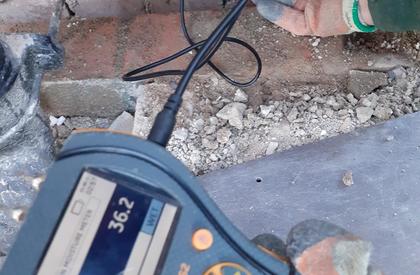Date:
We want residents to have a safe and secure home free from damp and mould.
We take any issues with damp and mould reported to us very seriously. A rigorous process is followed to ensure that all issues are investigated in an efficient way.
We encourage all residents to get in touch if they think you have damp and mould in your home. Report damp or mould online, call 0800 5870211 or email repairs@jrht.org.uk
Examples of work carried out to help solve issues with damp and mould
The first three images feature work being carried out to correct issues with no insulation in the eaves. First image (left) tiles on roof removed to access the eaves. Second image (middle) insulation installed and eaves ventilation trays added. Third image (right) completed work.
The last two images feature before and after pictures for insulation in cavity walls. First image (left) damp meter being used between outside bricks and cavity wall. Second image (right) new brick work after insulation has been installed. Completed work.
Example 1: 2 bedroom detached home
A resident contacted the Customer Access Team and reported damp on the ceiling and walls with black mould starting to show in various areas around their home. An appointment was made for a surveyor to visit the home.
What we did?
A surveyor visited the home and carried out an initial inspection of the home which highlighted insufficient insulation in parts of the loft. It appeared that some areas had not been insulated due to problems with access.
It was likely that the lack of insulation was a causing the damp. A follow up visit was arranged to investigate this further. During this visit, a problem with the cavity was also identified. The problem was allowing cold bridging between the outside and inside of the home leading to condensation forming.
Work carried out
Additional insulation was added to the roof, so it was fully insulated. This involved temporarily removing part of the roof. When the roof was put back on – additional space was allowed so that air could circulate effectively, and condensation would not occur in the future.
- Cavity walls were opened throughout the property and debris was removed.
- A cavity tray was added so air could flow.
- Weep holes were inserted to make sure that any moisture did not stay in the cavity.
- Additional cavity insultation was also fitted.
Example 2: 3 bedroom home at the end of the row
A resident contacted the Customer Access Team and reported mould growing in the bathroom at high level around the junction of the walls and ceilings as well as mould in the corners of the walls.
What we did?
A surveyor visited the home and carried out an internal inspection of the home to assess the cause and extent of the mould. They also examined the insulation and ventilation to determine the current levels.
During the visit, the following checks were made:
- Inspected the windows to see if they were any draughts and leaks. Also checked the trickle vents which were working.
- Took readings of both the humidity and temperature in the bathroom.
- Inspected the loft to check if any roof tiles had become dislodged, if any leaks were present, as well as measuring the depth of the loft insulation
- Checked the radiators were in place and had thermostatic control valves.
Work carried out
- After the visit, we arranged for a cleaning company to clean the areas with mould.
- We also arranged for a scaffold to be erected so that the cavity below the eaves could be inspected. We found that the upper section of the wall in the bedroom had been constructed as a half brick wall leading to cold bridging, condensation and the growth of mould.
- We have now installed additional insulation to the wall which will make the room warmer and help to prevent future mould growth.

